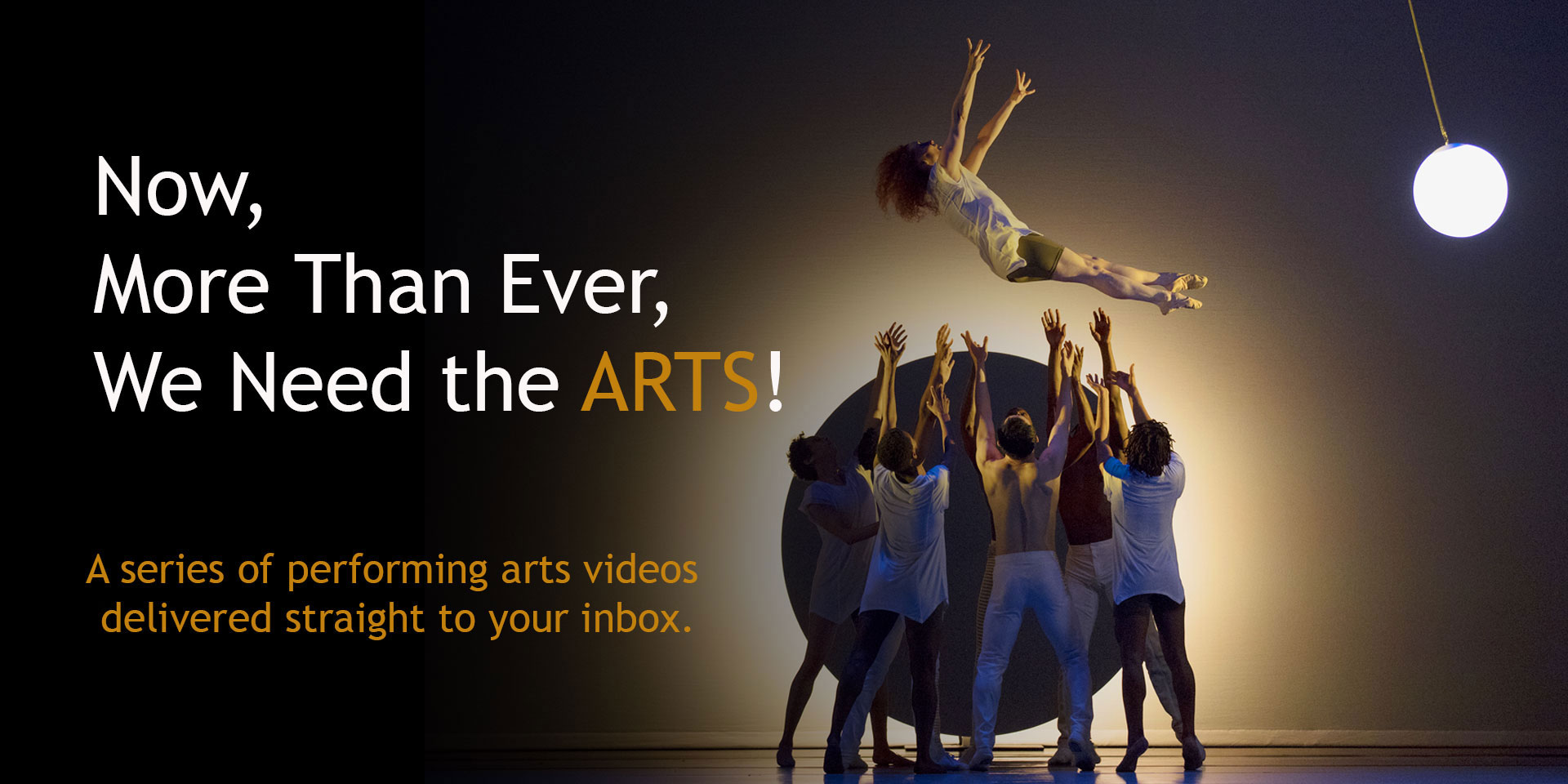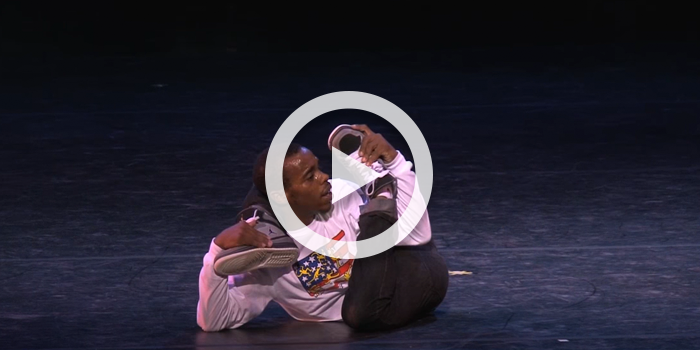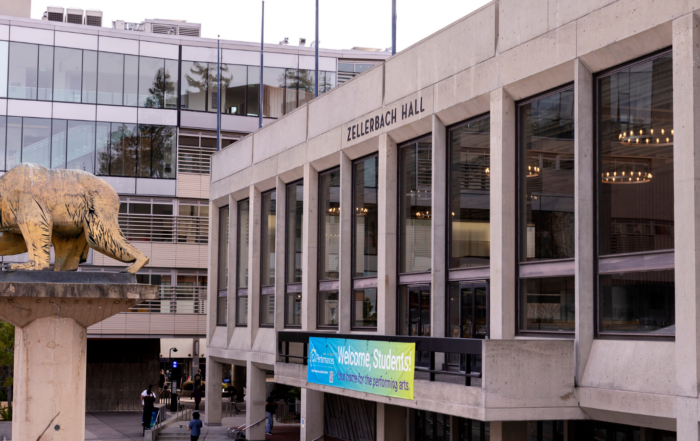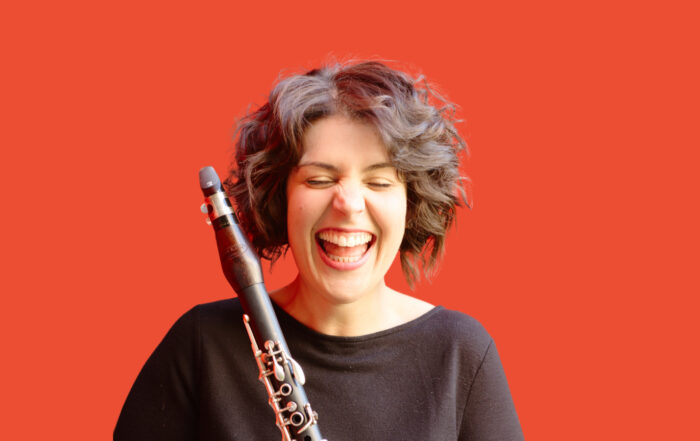Today’s selection helps turn our attention to the rewards—and risks—of live performance.
Now, More Than Ever, Issue 61
It has been a hectic past couple of months at Cal Performances, as we spent long hours finalizing plans for the 2021–22 season, which marks the exciting return of live performances to the UC Berkeley campus. (We were also busy closing out the spring Cal Performances at Home season, several programs of which remain available for home viewing through summer.) And given the recent announcement of our upcoming in-person events, today’s list helps turn our attention to the rewards—and risks—of live performance.
Now, More Than Ever, which has celebrated hundreds of great video-captured performances since the beginning of the pandemic, returns today after a short recess and will appear every two or three weeks throughout the summer… serving as a reminder of the pleasures and promise of what lies ahead in the coming season. We hope you’ll continue to enjoy these blogs over the next few months, as we look forward to seeing each other again at the concert hall!
Mozart: Piano Concerto No. 20 in D minor, K. 466
Maria João Pires, piano
Royal Concertgebouw Orchestra
Riccardo Chailly, conductor
Here’s a situation that must sit at the very top of any concert performer’s list of recurring nightmares—kind of the musician’s version of “not studying for the test.” The audience is in place. The orchestra is tuned and ready, and you sit, poised at the piano keyboard, ready to begin your performance of a particular Mozart piano concerto. All is ready as the conductor (in this case, the Italian Riccardo Chailly, then the music director of the Royal Concertgebouw Orchestra) raises his baton and gives the downbeat, and the orchestra launches into the opening tutti of a different concerto than the one you’ve prepared!
Your heart has to go out to Portuguese pianist Maria João Pires (an extraordinary artist who does not often travel to this side of the Atlantic), as she realizes she has prepared a different work for the performance (though this is identified as a concert in the video, the attire of the participants and audience points to it being an open rehearsal) and every response imaginable—from confusion and shock to utter despair—crosses her face. Yet so phenomenal are her powers of memory and concentration that somehow, she musters both her nerve and her superb reserves of skill to take on the composition without rehearsal or preparation. (I understand that Pires now divides her time between performance and organic farming; one has to wonder if this experience somehow played a part in that decision!)
I’ve always wondered how the rest of this rehearsal came off, but that’s what you get—the rewards and risks—with live performance; you never know what’s going to happen!
For a “surprise”-free take on this work, check out this lovely performance by the peerless Mozartian Mitsuko Uchida, who this coming season will perform two piano concertos by the composer with the Mahler Chamber Orchestra in Zellerbach Hall on March 27, 2022.
Rachmaninoff: Finale from Piano Concerto No. 3 in D minor, Op. 30
Martha Argerich, piano
Berlin Radio Symphony Orchestra
Riccardo Chailly, conductor
(If this video doesn’t begin at 27:37, please reset it.)
Same conductor this time, but an entirely different musical experience, as Chailly teams with the galvanic Martha Argerich, who virtually explodes out of the starting gate at the beginning of the final movement of Rachmaninoff’s Third Piano Concerto, nearly leaving players and conductor behind in the dust. One can only imagine that the tempo at which she chooses to present the opening theme is much faster than it was in rehearsal, as it seems immediately to present some significant challenges to the orchestra. The expressions on Chailly’s face register everything from exhilaration to pure terror!
This is the second time we’ve looked at this particular passage of music, the first last December, in a masterful performance by Leif Ove Andsnes and the Swedish Radio Symphony Orchestra under conductor Lionel Bringuier. The two performances are worth comparing. If Andsnes displays an almost superhuman sense of physical ease and serenity at the keyboard, Argerich is a powerhouse athlete, seemingly without physical limitations and pushing herself to extremes that she may herself wonder if she can achieve. Performances at this level are thrilling and inspirational to hear; even more so to watch in person (as you can hear from the audience’s reaction!).
Bernstein/“Socrates, Alcibiades” from Serenade, after Plato’s Symposium
Midori, violin
Boston Symphony Orchestra
Leonard Bernstein, conductor
Another perfect example of how unpredictable and memorable a live performance can be is this famous incident (recounted most recently on a national television broadcast when Midori was honored as a 2021 recipient at the 43rd Kennedy Center Honors). It’s short, but, like any great story, it’s well worth repeating. During her 1985 debut with the Boston Symphony Orchestra (at Tanglewood), and under the direction of Bernstein himself, the then-14-year-old violinist breaks a string—not once, but twice, and it’s the same string!—forcing her to accept instantaneous loans of replacement instruments from orchestra members. And all without missing a note!
Mahler: Conclusion of “Der Abschied” from Das Lied von der Erde
Christa Ludwig, mezzo-soprano
Israel Philharmonic Orchestra
Leonard Bernstein, conductor
A profound loss in recent months came with the death of the great Christa Ludwig, “who poured a lustrous voice into dramatically taut performances of opera roles—especially those of Mozart, Strauss and Wagner—and intimately rendered art songs as one of the premier mezzo-sopranos of the second half of the 20th century” (The New York Times). Ludwig died on April 24 at her home in Klosterneuburg, Austria. She was 93.
There aren’t many videos of Ludwig in live performance, but she was an incredibly versatile singer, equally at home in music by composers ranging from Mozart, Beethoven, and Verdi, to Wagner and Berg. And she had both the strength of will and the natural talent necessary to accomplish anything she wanted.
I only worked with her once, during her retirement, when she came to New York in 2014 to conduct a master class at Carnegie Hall. On that occasion, I remember her coaching a singer in Schumann’s “Der Soldat,” a song about a young man returning home after war. The vocalist was taking a remarkably poised approach to the music when Ludwig stopped him, remarking, “I don’t know if you’ve ever seen refugees, but I have, and the people who return from war are anything but poised. They are ravaged.” (She had been a teenager in Germany at the conclusion of WWII, though she offered no further reminiscence.) Ludwig then proceeded to lead the vocalist through the kind of review of the piece that not only revealed the benefits of her long experience as a singer, but her deep attention to the text. Here, in just a few minutes, one came to understand both her individual process and how personal this work was to her.
This performance of the last third of “Der Abschied” (“The Farewell”), the final song from Mahler’s The Song of the Earth (a work that Bernstein called Mahler’s “greatest symphony”), perfectly captures the spell—so soulful, so still—Ludwig was able to cast from the stage.
He dismounted and handed him the drink
of farewell.
He asked him where he would go
and why must it be.
He spoke, his voice was quiet. Ah my friend,
Fortune was not kind to me in this world!
Where do I go? I go, I wander in the mountains.
I seek peace for my lonely heart.
I wander homeward, to my abode!
I’ll never wander far.
Still is my heart, awaiting its hour.
The dear earth everywhere
blossoms in spring and grows green anew!
Everywhere and forever blue is the horizon!
Forever… Forever…
Reminiscin’
Judith Jamison, choreographer
Alicia Graf Mack and Jamar Roberts, dancers
This extraordinary duet, made by the great Judith Jamison in 2005, is all about connection, beautifully communicating its multiple depictions of intimacy. Set to Diana Krall’s throaty version of Joni Mitchell’s “A Case of You,” it features two of the greatest dancers from the Alvin Ailey American Dance Theater’s long line of magnificent performers. Today, Graf heads the dance division at Juilliard, while Roberts is making waves as the Ailey’s resident choreographer; it’s touching to see them together here, dancing in peak form at much earlier stages of their brilliant careers.
Note: Just weeks ago, Jamar Roberts’ brilliant Holding Space, a Cal Performances co-commission, saw its world premiere on Cal Performances at Home. It remains available for on-demand viewing through September 8. Don’t miss it!
Miriam Makeba and Jerry Rogovoy: “Pata Pata”
Angélique Kidjo, vocals
One of the biggest pleasures in store during Cal Performances’ 2021–22 season will be welcoming singer, composer, activist, and humanitarian Angélique Kidjo as our first season-long artist-in-residence. Very much a detailed and thoughtful artist and an impeccable vocalist, Kidjo is also an instinctive, incendiary dancer, with the energy of a dozen other performers. With every concert, she reminds us of how exhilarating—and just plain fun—it can be to sit under the same roof with friends and strangers during a great performance. That is, until you just have to start dancing yourself!
Here she absolutely loses herself within “Pata Pata,” the great Afro-Pop dance song that put South African singer Miriam Makeba, Kidjo’s mentor and friend, on the map.
Every Friday and Saturday night,
It’s Pata Pata time!
The dance keeps going all night long,
Til’ the morning sun begins to shine!
Now, More Than Ever Full Playlist
Now, More Than Ever Spotify Playlist








